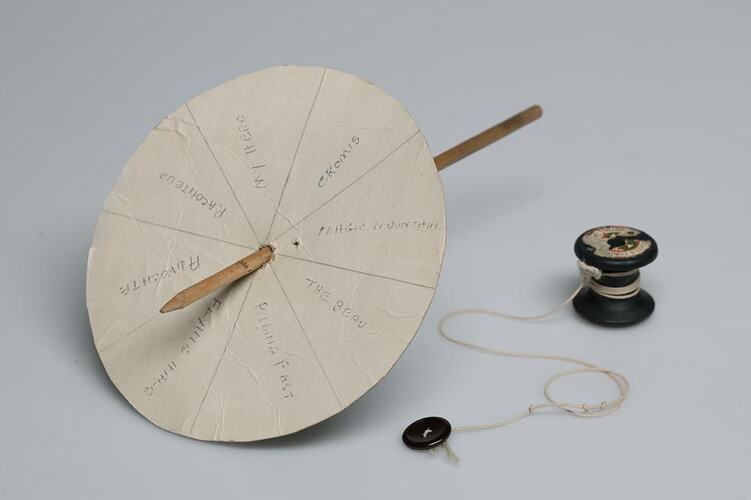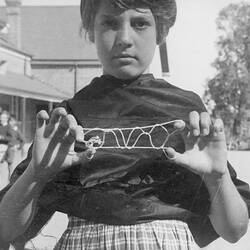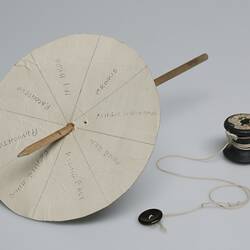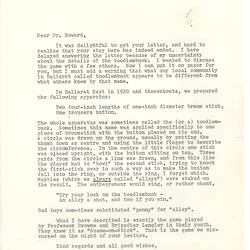Exerpts from interview of Dr June Factor by Dr Carla Pascoe Leahy, 12 July 2006, discussing the toodlembuck toy and associated play
Carla Pascoe Leahy: Could you tell us a little bit about how this [toodlembuck SH 990230] came into the [Museums Victoria] collection and what its story is?
June Factor: The toodlembuck is a gambling implement, used by children in Australia, from when we're not quite sure, but I've been able to track it probably into the '60s but no later than that.
At the time of the Melbourne Cup the proud owner and maker of the toodlembuck would write names of the horses on a circle of cardboard, a bit like the segments of an orange and there's a hole in the middle.
It's quite a complicated little thing. You put a butcher's stick, a thing that butchers used to to hold bits of meat together. Then there's a cotton reel with a pin and a thread.
The idea is that the toodlembuck gets spun round and where that button or pin lands, that's the winning horse. It's not the horse that wins at the Melbourne Cup, it's the horse that wins in the spin. And children used to bet on this with cherry bobs (cherry pips). The first Tuesday of November of course, in Australia, is the Melbourne Cup in Flemington and there was a time when cherries must have been available in some profusion at that early time.
I've noticed that it's getting later and later to get cherries in the shops in Melbourne so I don't know that you could do it that easily now. The owner of this proud contraption would then keep some of the cherry bobs and some of course would go to the proud winner of the horse - the one where the pin went/landed.
Now this particular toodlembuck comes from Dorothy Howard, [who] was the remarkable American folklorist and educator who came to Australia in the mid '50s and who travelled the land, observing and noting down what it was that children did in their free time, the games, the rhymes, the riddles, the jokes, etc. She was a wonderful ethnographer.
She was here [in Australia] for 10 months, went back to the United States in 1955 and took with her many of the objects that she collected, as well as all her tightly-written boxes of games and words and all the rest of the stuff that she collected. We set up a correspondence and in fact ended up having a quite remarkable friendship across generations and across space. I used to visit her and I gradually brought back, with her great approval and pleasure, all the material that she had collected, both the written material and the objects.
The toodlembuck [SH 990230, made by schoolmistress Miss Kelly around 1954 as an example of one she had used as a child] was one of the objects. I have [had?] never seen one before, nor had I ever heard of one. I think this one was made for her, so she didn't actually collect this 'on the field' as it were, but an older woman who had used it and was describing it, sat down and made it.
Carla Pascoe Leahy: So this would have been made in the 1950s but may very well represent a tradition of several decades ago, yes?
June Factor: I have tracked the game, or a variant, not a game with a circle like this, and not in fact a game played by children, but there's a description in one of the old collections of British folklore of men in Newcastle in England playing a gambling game which involved a ball, I think, and the person who rolled it would call out: 'Roll up, roll up, roll up, your toodlembuck'. I suspect that it's come to us, changing of course the format and words have changed, and it has remained a gambling game. It is a really interesting history.
Carla Pascoe Leahy: Mm, and it presumably wouldn't have been looked on very kindly in the school playground either?
June Factor: No, and yet I've never read ever, ever seen anything, I've never seen anything written - no that's not quite true, I have actually seen references to the toodlembuck in memoirs, but I've never seen any reference to it in the adult writing about adult attitudes to children - for example, of teachers. I suspect, like so much else, that where it goes on in the playground it's invisible. For most adults they don't even notice it, or don't realise what the kids are doing, that they are in fact gambling.
Why cherry-bobs... I mean obviously they must have been available, but it does raise really interesting problematic questions about the symbolic nature of so much play, in this case the cherry-bobs represents money and is as much valued as if it were money.
I think it's a very interesting game, and I'm rather sorry that it seems to have disappeared. Every now and again you'd get a wicked thought about: 'Should you take a toodlembuck into the classroom and sort of start 'anew'? But I don't. I think on the whole children are the instigators or the initiators of the traditions as they go, even when they come from the adult world.
More Information
-
Keywords
-
Localities
-
Authors
-
Article types



